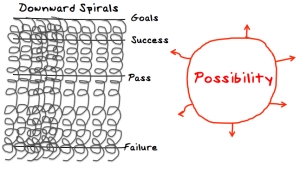By Tim Riesterer, Corporate Visions
In September, we hosted our annual Sales and Marketing Messaging Conference in Chicago under the theme of “Breaking the Status Quo.” While there were a lot of excellent presentations that challenged our approaches to sales and marketing messages, there was one presentation that stretched us personally and professionally and has really stuck in my mind.
Ben Zander, conductor of the Boston Philharmonic Orchestra, delivered a keynote that could only be described as a mind-bending experience, not a presentation. I’ve never witnessed 400 senior business executives so emotionally engaged in a speech.
(When’s the last time you saw your colleagues singing Beethoven’s Ode to Joy in German – at the top of their lungs with huge hand gestures and giant facial expressions. Yeah, that happened, and people loved it.)
Zander convinced people to pack the front rows prior to starting his speech. In most conferences, it helps to sit in the front row to be able to read all of the bullet points in the deadly dense onslaught of slides. But, in Zander’s case, he didn’t use any slides. Being in the front row meant you were going to be “leaning into possibilities,” unlike the back row people who “observe, criticize and look for a quick getaway.”
Zander used his piano as an important prop to demonstrate how “one-buttock playing” can transform a dull, boring piece of music into a story that sucks you in and takes you on a magical journey. His challenge: How can we be one-buttock players when we engage people we lead?
Zander drew simple images on flip charts. Yes, he used whiteboard techniques to make key points memorable, showing the contrast between “downward spiral” thinking and conversations vs. “radiant possibilities.” Now, every time I have a conversation with someone I can visualize either the downward spiral or radiant possibility whiteboards, and make a conscious decision to change the dialogue to be more productive.
Throughout the keynote, Zander was on a secondary mission to disrupt status quo thinking about classical music. Since only about 3 percent of the population is comprised of die-hard fans, he used not only stories, musical examples and group sing-alongs to make a point about leadership and interpersonal communications, he also managed to convert more than a few folks to reconsider their stance on the symphony. Bravo, Ben Zander.
Here’s a clip of Ben Zander from a recent TED presentation that is well worth watching and will leave you wanting more.
http://www.ted.com/talks/benjamin_zander_on_music_and_passion.html
Summary of the Visual Storytelling techniques used by Zander:
- Stories – he embedded personal stories to “enroll” the audience, punctuate key points and connect with people’s emotions.
- Dramas – he engaged the audience in sing-alongs, challenging the audience to repeat the song three times with more gusto to prove we hold back.
- Whiteboard – his two flipchart visuals created memorable take-aways, and he didn’t display a single PowerPoint slide, even though there were 400 people in the room for two hours.
- Props – in Zander’s case, a grand piano served as a prop for demonstrating how people can be more engaging in their presentation.





